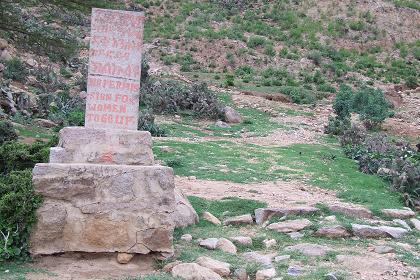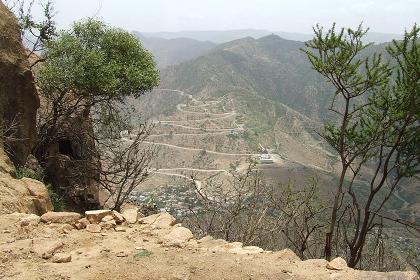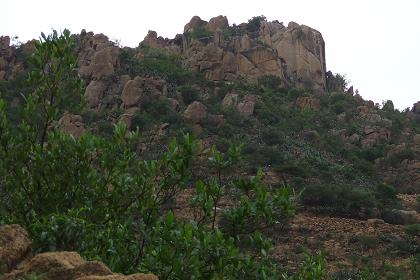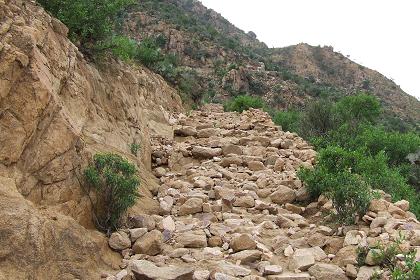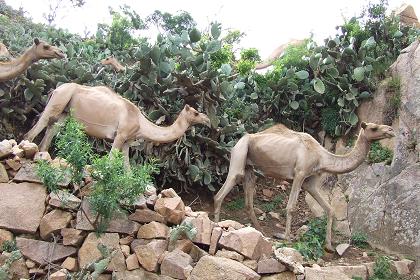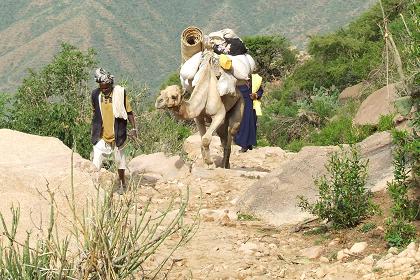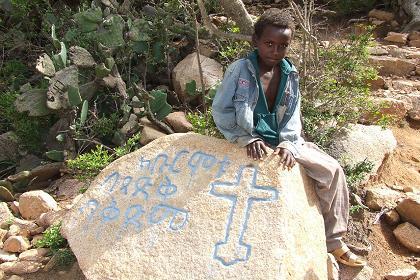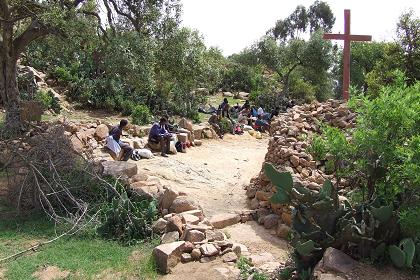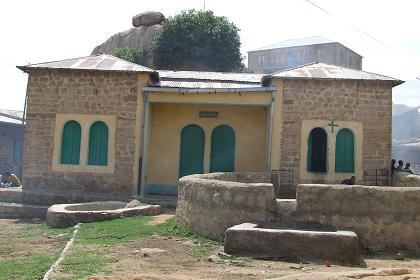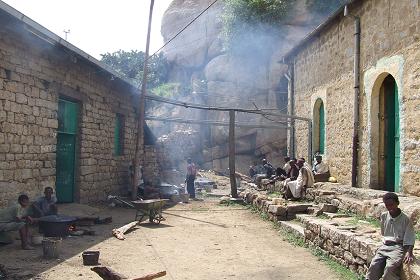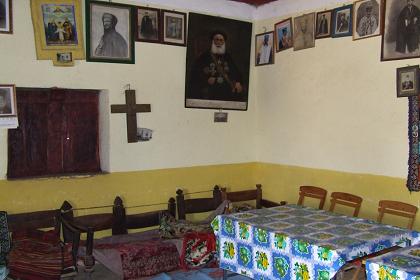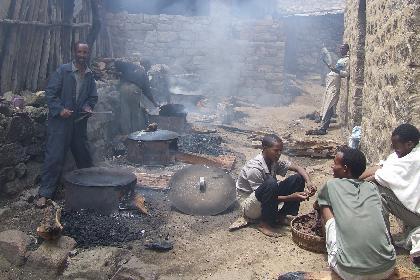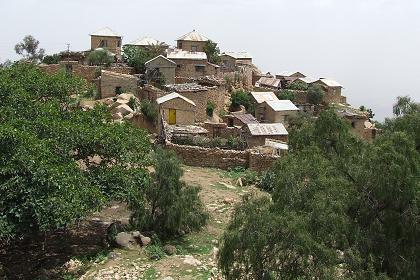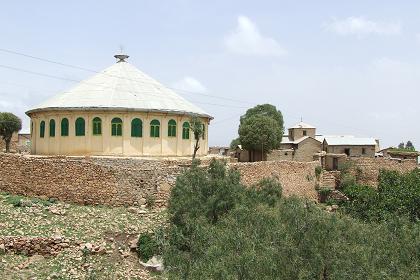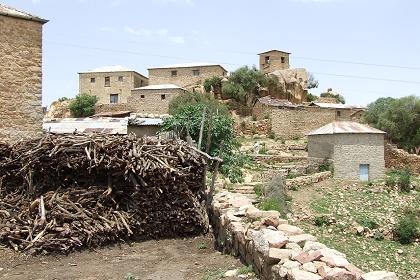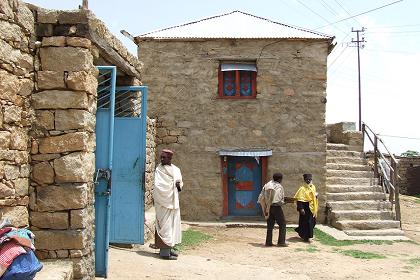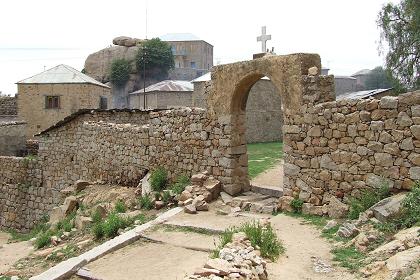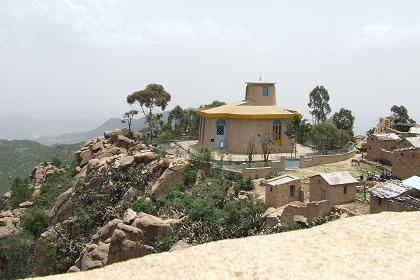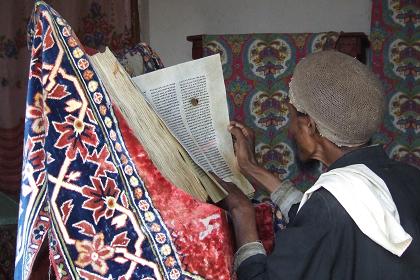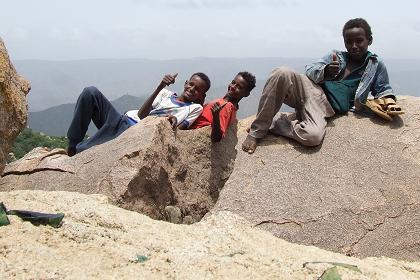| Eritrea July 2006 | ||||||
| Mon | Tue | Wed | Thu | Fri | Sat | Sun |
| 01 | 02 | |||||
| 03 | 04 | 05 | 06 | 07 | 08 | 09 |
| 10 | 11 | 12 | 13 | 14 | 15 | 16 |
| 17 | 18 | 19 | 20 | 21 | 22 | 23 |
| 24 | 25 | 26 | 27 | 28 | 29 | 30 |
| 31 | ||||||
| Eritrea August 2006 | ||||||
| Mon | Tue | Wed | Thu | Fri | Sat | Sun |
| 01 | 02 | 03 | 04 | 05 | 06 | |
| 07 | 08 | 09 | 10 | 11 | 12 | 13 |
| 14 | 15 | 16 | 17 | 18 | 19 | 20 |
| 21 | 22 | 23 | 24 | 25 | 26 | 27 |
| 28 | 29 | 30 | 31 | |||
| next page | previous | |||||
| July
and August 2006 Festival Eritrea 2006 |
||||||
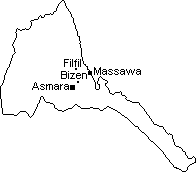 |
||||||
Debre Bizen Monastery - August 8th 2006
I get up at 5:00. Fifteen minutes later I am on my way to the bus station, on foot because it is not far from the center. Halfway a minibus stops next to me. "Where are you going?" When I tell the driver I am going to the Massawa bus station, he offers to bring me there, although it is not his destination. In any other African country there is a good chance this is a trick to rob you. But in Asmara it is the remarkable kindliness and the pride and compassion of the people to help you.
At 5:30 I am at the bus station and yet another 15 minutes later we are on route to Massawa. The military at the checkpoint is not ready to register my permit to travel. It is too dark. With my flashlight I assist the men, illuminating the paperwork, so the other passengers of the bus do not have to wait to long. On route there is a small delay: a stone got stuck between the double wheel on the rear axe. With the help of one of the passengers, the driver fixes the problem.
At 6:30 I arrive in Nefasit, and I can start my walk to Debre Bizen. I ask the directions to Debre Bizen to one of the local people. He shows the rough direction, pointing with his finger, unable to communicate in English. But soon I do not know what path to take: the first few hundred meters I follow a path that ends at the police station of Nefasit. A policeman asks me to wait for a few minutes. He will walk with me, and show me where the trail starts.
When I pass a stone with the words "No permission for woman to go up", I know I am on the right trail. When a small boy accompanies me, and offers to carry my bag (with water and some food), I agree. Later two of his friends join us. I do not need so many guides, but you never know what might happen. There is always the risk of getting stuck because of an injury, or an attack by hungry baboons. .
I remember my last visit to Debre Bizen very well. I was absolutely exhausted, and the risk to wrench the ankle, or worse, is very likely. The path sometimes looks like a complete chaos of irregular stones, some of them covered with sand. Therefore I have to watch almost every step on the six kilometers walk / climb to the monastery. With no particular advance training, this is a very tiresome trip.
But the boys show a lot of respect for me, and allow me to have some rest when I need it. When I rest on a large stone, one of them uses the time to collect beles, a cactus fruit. He rubs the fruits on a stone to remove the thorns and with a knife he removes the skin of the fruit, so I can eat it. Two of them is enough. The fruits stimulate the digestion and there are no sanitary facilities on this mountain. The rest is for the boys themselves.
More boys link up to our small group, carrying supplies for the monastery's annual festival next Friday. I guess they are in for a big tip, but I do not need an army to finish the hike, and some of them are a bit impolite, so I decide to ignore them. And when I spend more time resting than walking, they lose their patience and move on with their bundles of fuel wood and bags with foodstuff.
At 10:00 we reach the monastery's compound. The landscape changes from thorny bushes and cactuses to an evergreen forest and gardens covered with grass and green bushes. We have to take our shoes off. It is holy ground. I am welcomed by the monks and show them the permit. It is okay anyway. If the visitor spends so much energy to visit Debre Bizen, he must be a real friend.
A monk that must be the regular spokesman, introduces himself and and an old grey-bearded monk, who is the Church Father of the Debre Bizen monastery. He speaks in perfect English, telling me a short story of the Debre Bizen monastery, and asks me if I like the place. It is difficult to give an objective answer, so short after my arrival. Climbing up six kilometers up is literally breathtaking.
We are directed to a stone bench against the wall of what looks like a mediaeval village with small honey colored houses and a few round chapels. One of the other monks washes my feet; another one brings candy and breadsticks for me and the three boys. From my seat I watch the courtyard, a well containing rainwater and some small houses, one of them functioning as a small suwa brewery.
I watch the monks making suwa. August 11 is the monastery's birthday and festival. This is the reason why I had to go alone. Everyone will visit Debre Bizen on August 11, but by that time I will be back in Amsterdam. A large stone trough is filled with the dark brown liquid, made of roasted sorghum dough and rainwater, fermenting for a couple of days until it contains some five percent alcohol. When I want to make a picture, the monks hide themselves behind the door.
I am invited into a dining room. Paintings of Orthodox Church fathers and carved wooden crosses decorate the walls. After a few minutes a monk brings in tea, injera and breadsticks. The injera is dark and dry, but tastes very good. I have been told that all food is produced in the monastery's gardens. Except the tea I guess. I am not very hungry. I this climate dominated by sunny weather I prefer to finish the pot of tea.
When I am finished, my three guides show me the ancient buildings of this religious village. The boys climb on walls, close to the edge of a steep cliff, ro show their bravery. The walls are protected with glass fragments, that should keep uninvited visitors out. Bereket and Semir invite me to follow them balancing on top of the world. No, thank you! I don't want to die yet. In one of the small houses a monk reads from a oversized book with religious texts in Ge'ez, the Coptic liturgical language. Before he knows I'm there, I make his picture.
At 12:00 we return to Nefasit. The reward of this morning's hard work is stunning views over the mountain ridges and the valleys below. Bereket explains what we are observing: Mai Habar on the right and Nefasit on the left below us. It gives me confidence to do the walk from Nefasit to Mai Habar in future. The decent of Mount Bizen is easy. Only the rough path requires watching almost every step I take.
Descending the snaking rock strewn track, I share my water (filled the bottle at the monastery) with exhausted people coming up. We make a stop every once and a while, to enjoy the impressive views, and to make pictures. At 13:30 it starts to rain. The boys want me to hurry. I don't want to get wet, but I don't want to get hurt either. The rain makes the stones even more slippery. Fortunately it is raining only a few minutes.
Down in Nefasit at 14:00, I give the boys a generous reward that I promised them on our way up. They have done their very best, and taken good care of the elderly tourist, patiently waiting when necessary, allowing to see me all that mount Bizen has to offer to a tourist, and last but not least: bringing me down safely My guides want to know when I will be back, if I know other tourists that need their services.
In front of a bar next to the Massawa - Asmara road (and bus stop) I drink a large bottle of mineral water. Buses to Asmara are rare around this time, but I am lucky again. Even before I can finish my drink, at 14:20 a bus stops and it has one seat available. On our way to Asmara it starts to rain cats and dogs. So I guess I am lucky again, not to be walking on Mount Bizen's slopes at this time of the day.
One hour later I am back in Asmara, and spend the rest of the day looking for all kind of collectors items, souvenirs and cargo for the return trip. It is raining all afternoon, but wherever I go, I am welcome to take shelter in small workshops and shops, making new friends. "Welcome to Eritrea, welcome in my shop. Please have this chair. And some rest. But no pictures please".
"No permission for women to go up" - start of the 6 kilometer trail to
Debre Bizen, close to Nefasit (altitude 1,648 meter or 5,407 feet).
The zigzag road from Asmara to Massawa - View from Mount Bizen.
The cliffs on top of Mount Bizen (and two kilometers to go).
The rock strewn track winding up Mount Bizen.
Three camels coming down - Mount Bizen Eritrea.
Camels coming up - Mount Bizen Eritrea.
Filmon, one of my guides on a landmark indicating the
end of the hike: one kilometer from Debre Bizen Monastery.
The compound of the Debre Bizen Monastery - Mount Bizen
(The monks will ask you to take off your shoes from here).
The compound of the Debre Bizen Monastery.
Monks making suwa in an alley of this hilltop village - Debre Bizen Monastery.
The dining room for the guests of the Debre Bizen Monastery.
Monks making suwa - Debre Bizen Monastery.
The compound of the Debre Bizen Monastery.
The compound of the Debre Bizen Monastery.
The compound of the Debre Bizen Monastery.
The compound of the Debre Bizen Monastery.
The compound of the Debre Bizen Monastery.
The compound of the Debre Bizen Monastery.
Praying Monk - Debre Bizen Monastery.
Semir, Bereket and Filmon - My guides on top of
Mount Bizen (altitude 2,463 meter or 8,081 feet).
